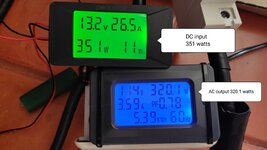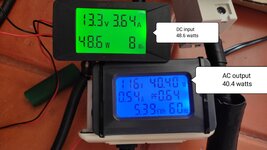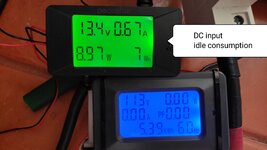poseidon22
Newbie
I have an old sine wave inverter 12V 1500W, unfortunately the control of the MOSFETs no longer works. That's why I built a circuit with EGS002 as shown in the EGS002 data sheet. There 4 IRF3205 are controlled.
My inverter has 4 groups of 9 IRF3205s each, a total of 36 pieces. I controlled each group as a single MOSFET with 1 piece 4.7Ω resistor and 1 piece diode IN4148. As a pull-down resistor I used 7.5K for each group.
The inverter works with this circuit. However, if it is loaded with more than 450 watts, the voltage collapses. Can someone give me information about what is wrong with my circuit. Do I have to drive each individual transistor with a 4.7Ω resistor + diode IN4148 and a pull-down resistor?
My inverter has 4 groups of 9 IRF3205s each, a total of 36 pieces. I controlled each group as a single MOSFET with 1 piece 4.7Ω resistor and 1 piece diode IN4148. As a pull-down resistor I used 7.5K for each group.
The inverter works with this circuit. However, if it is loaded with more than 450 watts, the voltage collapses. Can someone give me information about what is wrong with my circuit. Do I have to drive each individual transistor with a 4.7Ω resistor + diode IN4148 and a pull-down resistor?


